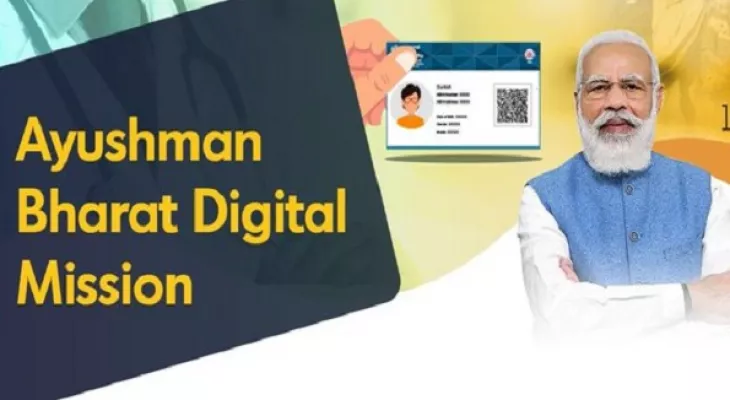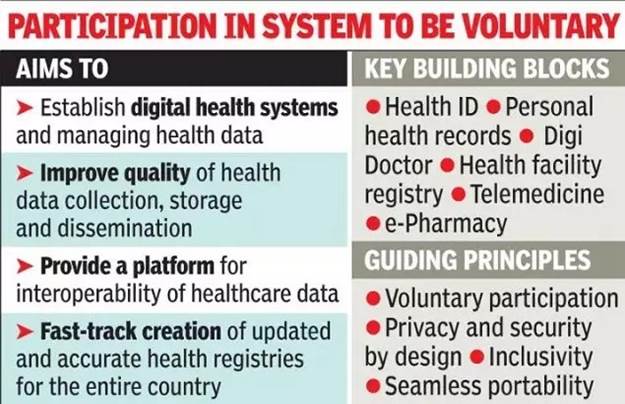AIR INDIA RADIO
AYUSHMAN BHARAT DIGITAL MISSION

Copyright infringement not intended
In News
- The National Health Authority has announced an upgraded ABHA mobile app to manage health records under Ayushman Bharat Digital Mission.
Details
- It will ensure access to quality healthcare by promoting the use of technologies such as telemedicine and supporting the national portability of health services.
- Citizens can create their ABHA (Ayushman Bharat Health Account) numbers, to link their digital health records.
- The ABHA mobile application can be linked with the 14 digits randomly generated ABHA number.
- The National Health Authority will be the implementing agency of the Ayushman Bharat Digital Mission (ABDM).
- It aims to create a National Digital Health ecosystem that supports universal health coverage in an efficient, accessible, inclusive, affordable, timely and safe manner.
- Other functionalities such as Login via face authentication/fingerprint/ biometric and the ability to scan QR codes.
- The ABHA app is available for download from the Google Play Store and already has over 4 lakh downloads.
- The app will help citizens to create their longitudinal health records. The patients can access their health records and it will empower them.
- It will help them to save their health history on a single platform and access or share their health records anytime and anywhere without the worry of losing them.
About Ayushman Bharat National Digital Mission
- It will ensure access to quality healthcare by promoting the use of technologies such as telemedicine and supporting the national portability of health services.
- Citizens can create their ABHA (Ayushman Bharat Health Account) numbers, to link their digital health records.
- The National Health Authority will be the implementing agency of the Ayushman Bharat Digital Mission (ABDM).
- It aims to create a National Digital Health ecosystem that supports universal health coverage in an efficient, accessible, inclusive, affordable, timely and safe manner.

Copyright infringement not intended
Concerns
- Privacy concerns and misuse of data.
- Exclusion of citizens and denied healthcare due to System failure or technical errors.
Present status of Healthcare in India
- According to WHO Study, 34% of Indians are physically inactive.
- The fertility rate in 23 States and UTs including all the Southern States is below the Replacement rate while it is higher in several States in Central, east and northeast India.
- Despite increasing knowledge of Contraceptive methods men have not taken up the responsibility of managing fertility.
- India 3rd the most obese nation after the US and China.
- Non Communicable diseases are top killers' Diabetes, Cancer and heart disease Cause over 70% of deaths.
Steps by the Government
- Promotion of Institutional deliveries through Cash incentive under Janani Suraksha Yojana.
- Janani Shishu Suraksha Karyakram: Free ante-natal Check-ups, Postnatal Care and treatment of Sick infants till one year of age.
- Providing Reproductive, Maternal, Newborn, Child and Adolescent Health Services, the establishment of Special Newborn Care Units.
- Home Based Newborn Care is being provided by ASHAs.
- MAA for improving breastfeeding practices.
- Pradhan Mantri Dialysis Program.
- Mission Indradhnaush: Expanding full immunisation Coverage, the introduction of new vaccines.
- PM Swasthya Suraksha Yojana for strengthening the tertiary health Sector.
- POSHAN Abhiyaan to address Malnutrition.
- Iron and folic acid Supplementation for Prevention of Anaemia, home visits by ASHAs to promote breastfeeding and promote the use of ORS and Zinc for management of diarrhoea in children.
- Medical Devices Rules, 2017: Transparent regulatory System, Ensure Safety and quality of medical devices, Allowed 100% FDI in medical devices Sector to Promote Make in India.
- National Health Resource Repository: Create a reliable, unified registry of the Country’s healthcare resources showing the distribution pattern of health facilities and Services between Cities and rural areas - ISRO is a technology Partner for providing data Security.
- Allowed 100% FDI in the Medical devices Sector to promote Make in India.
- Kayakalp initiative to Promote Cleanliness, hygiene and infection control practices in public health facilities.
National Health Policy 2017 targets
- Shifts From communicable to non-communicable diseases.
- Collaborating & regulating the private sector.
- A shift from Sick-care to wellness.
- Increase Life Expectancy at birth from 67.5 to 70 by 2025.
- Reduction of TFR to 2.1 at national and Sub-national levels by 2025.
- Reduce Five Mortality to 23 by 2025 and MMR from current levels to 100 by 2020.
- Reduce infant mortality rate to 28 by 2019.
- Reduce neonatal mortality to 16 and the stillbirth rate to “single-digit” by 2025.
- Reduce premature mortality from cardiovascular diseases, cancer, diabetes or chronic respiratory diseases by 25% by 2025.
Steps need to be taken
- Reduce the Pressure on Secondary and tertiary hospitals by investing in Preventive and Primary Health Care facilities.
- Early detection and Prevention.
- Provide adequate protection to doctors.
- Increasing the Doctor-Patient ratio.
- Reduce Out Of Pocket Expenditure.
- Increase the number of vaccines under Mission Indradhanush.
- Increasing the number of drugs and medical devices under price control.
- The Ministry Should Standardise the Cost of Certain treatments.
- Raising Public Health expenditure to 2.5% of GDP.
- Provide accessible, affordable and quality health care.
- Inform and educate people about the traditional Systems of medicine.
- Ayurveda Doctors and Yoga Teachers for Rural Areas.
- Improve Hospital access, Health worker density, and Access to essential medicine.
- Mobile Medical Units to Provide outreach Services in rural and remote areas.
Way Forward
- Based on the foundations laid down in the form of Jan Dhan, Aadhar and Mobile (JAM) trinity and other digital initiatives of the government, Ayushman Bharat Digital Mission is creating a seamless online platform through the provision of a wide range of data, information and infrastructure services, duly leveraging open, interoperable, standards-based digital systems while ensuring the security, confidentiality and privacy of health-related personal information.
NEWS IN BRIEF: PRELIMS SPECIAL
NATIONAL ACHIEVEMENT SURVEY 2021
- The Union Ministry of Education has released the National Achievement Survey (NAS) 2021 report.
- The National Achievement Survey (NAS) 2021 report assesses the school education system through a comprehensive evaluation survey of children’s learning in classes 3, 5, 8 and 10.
- The survey reflects the overall assessment of the school education system, it covers;
- Government Schools (Both Union and State Government).
- Government Aided Schools.
- Private Unaided Schools.
- The subjects covered are;
- Language, Mathematics & EVS for class 3 & 5.
- Language, Mathematics, Science & Social Science for class 8.
- Language, Mathematics, Science, Social Science and English for class 10.
- Nearly 34 lakh students from 1.18 lakh schools in 720 districts have participated in the survey.
- The survey was managed through the technology platform designed and developed by National Informatics Centre (NIC).
- According to the survey data, nearly 80% of students during the pandemic have found learning “burdensome” and felt that they would learn better in school.
- Nearly 24% of students responded that they had no digital device at home.
- Approx 45% of students found the digital learning experience “joyful”, and 38% also said that they had difficulties in learning.
- The Survey found that out of 500 scores, students across various classes performed better in languages, but lagged in subjects like mathematics and science.
- In Class 3, students scored the highest in languages (323), followed by EVS (307) and mathematics (306).
- Across various subjects and classes, SC, ST and OBC students performed worse
https://newsonair.gov.in/News?title=Ministry-of-Education-releases-National-Achievement-Survey-2021-report&id=441657
INDIAN CEO ALLIANCE
- The World Economic Forum (WEF) launches the India chapter of the Alliance of CEO Climate Action Leaders to supercharge India’s climate action and decarbonization efforts.
- The Indian CEO’s Alliance has been launched to boost Prime Minister Narendra Modi’s ‘Panchamrit’ pledge for Net Zero carbon emission by 2070.
- It will bring together the government, businesses, and other key stakeholders to achieve the Indian Prime Minister’s ambitious five-part ‘Panchamrit’ pledge.
- A collaboration between the management consultancy Kearney and the Indian think-tank Observer Research Foundation will serve as a high-level platform to support business leaders in planning and implementing plans and programmes to achieve climate targets, including net-zero economic growth.
- It will leverage learning and experiences from global projects such as the Alliance of CEO Climate Leaders and the First Movers Coalition.
- The alliance has become part of India’s climate action agenda which includes, Trillion Trees, Moving India for rapid electric vehicle deployment, clean energy financing, Food Innovation Hubs, Stakeholder Capitalism matrices and Clean Skies for Tomorrow.
About Panchamrits
- In the 26th Conference of Parties (CoP26) to the United Nations Framework Convention on Climate Change (UNFCCC), Prime Minister Narendra Modi announced the It includes:
- India will get its non-fossil energy capacity to 500 Gigawatts by 2030.
- India will meet 50% of its energy requirements by 2030 with Renewable energy.
- India will reduce its projected carbon emission by one billion tonnes by 2030.
- India will reduce the carbon intensity of its economy by 45 per cent by 2030.
- India will achieve net zero by 2070.
https://newsonair.gov.in/News?title=India-and-US-sign-Investment-Incentive-Agreement-in-Tokyo&id=441520
INDIA-USA INVESTMENT INCENTIVE AGREEMENT
- India and USA signed the Investment Incentive Agreement (IIA) in Tokyo, Japan which is expected to enhance investment support from America’s development finance institution in a wide range of sectors.
- The IIA was signed by foreign secretary Vinay Kwatra and Scott Nathan, the chief executive officer of the US International Development Finance Corporation (DFC).
- The agreement is considered a legal requirement for DFC to continue providing investment support in India.
- The agreement supersedes another similar pact signed between the governments of India and the US in 1997.
- Cooperation under DFC:
- The proposals worth four billion dollars are under consideration by Corporation for providing investment support in India.
- The Corporation has provided investment support in sectors like COVID-19 vaccine manufacturing, healthcare financing, renewable energy, financial inclusion and infrastructure among others.
- DFC or its predecessor agencies have been active in India since 1974 and have provided investment support worth $5.8 billion, of which $2.9 billion is still outstanding.
https://newsonair.gov.in/News?title=India-and-US-sign-Investment-Incentive-Agreement-in-Tokyo&id=441520
INDIA-USA INVESTMENT INCENTIVE AGREEMENT
- To commemorate the year-long celebration of the 250th Birth Anniversary of Raja Ram Mohan Roy, the Ministry of Culture held an inaugural ceremony under Azadi Ka Amrit Mahotsav.
- He is known as the Maker of Modern India, Father of Modern India and Father of Bengal Renaissance.
- He introduced several social reforms and protested against many social evils, superstitions, inhuman practices and customs.
- He received his traditional Sanskrit learning at Banaras and Arabic and Persian learning at Patna.
- Learnt English, Greekand Hebrew, also knew French and Latin.
- He learnt about Hinduism, Islam, Christianity and Judaism.
- Wrote several books in Bengali, Hindi, Sanskrit, Persian and English.
- He supported the introduction of English education in India, which was necessary to promote enlightenment and knowledge of science.
- He advocated belief in a universal religion based on the principle of one supreme God. He condemnedidol worship and the rites and rituals.
- Title 'Raja' was given by Mughal emperor Akbar Shah II.
- He fought against Sati, Child marriage and the Prohibition of widow remarriage.
- In 1828, he founded Brahmo Sabha or Brahmo Samaj.
- He promoted the worship of one god and brotherhood and interdependence.
- He wanted to combine the goodness of western ideals and Indian culture.
- He set up Anglo Hindu College in Calcutta in 1822 .
- He published in different languages, like Sambad Kaumudi and Mirat-ul-Akbar.
https://newsonair.gov.in/News?title=Year-long-celebrations-of-250th-Birth-Anniversary-of-Raja-Ram-Mohan-Roy-begins-today&id=441481
1.png)





